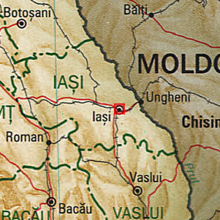Iași
![]()
This article is about the city in Romania. For other meanings, see Iași (disambiguation).
Iași [jaʃʲ] ![]() (German Jassy, obsolete Jassenmarkt, Russian Яссы Jassy, Hungarian Jászvásár, Armenian Յասի Jassi, Turkish Yaş) is a university town in northeastern Romania in the Moldavian region and the capital of the county of the same name. Historically it was the most important city of the Principality of Moldova and later the second most important city in Romania, today it is the seat of the Northeast Planning Region.
(German Jassy, obsolete Jassenmarkt, Russian Яссы Jassy, Hungarian Jászvásár, Armenian Յասի Jassi, Turkish Yaş) is a university town in northeastern Romania in the Moldavian region and the capital of the county of the same name. Historically it was the most important city of the Principality of Moldova and later the second most important city in Romania, today it is the seat of the Northeast Planning Region.
Iași is the fourth largest city in Romania with 290,422 inhabitants (2011) and is considered by some to be the "cradle of Romanian culture". Many Romanian personalities and artists lived here.
Location
The city is located 20 kilometers west of the border with the Republic of Moldova and about 400 km as the crow flies north of Bucharest. The surrounding area is hilly and agricultural. The small river Bahlui, a right tributary of the Jijia, flows through the city. Iași is called the "city of the seven hills", similar to Rome, which surround the city.
Neighbouring towns in Romania are Vaslui, Bacău, Roman, Botoșani and Suceava, and in Moldova Ungheni and Bălți. In 1849 Fedor Count of Karaczay wrote:
"In the Vltava, and especially in Jassy, the traveller finds himself, so to speak, on the hem of the Orient, in a place where Asiatic luxury and Oriental wealth in general merge, as well as they can, with European customs."
- Count Karaczay

Iașis situation
History
Archaeological excavations have found traces of the Cucuteni-Tripolje culture, about 5,000 years old. Iași was first mentioned in the 14th century, during the reign of Alexandru cel Bun.
Modern Times
From 1565 to 1859 it was the capital of the Principality of Moldavia, from 1859 also the capital of the newly founded Principality of Romania, until it was replaced by Bucharest in 1862. The name Iași is associated with the so-called Golden Period of Romanian culture.
In the course of the Austro-Turkish War from 1787 to 1791, Iași was occupied by the imperial army on 18 April 1788.
During the First World War, the city was the provisional capital of Romania from 1916 to 1918.
During the Second World War, the air forces of the Soviet Union carried out air raids on the city on 26 June 1941. Another bombing took place on June 28.
Pogrom of Iași
→ Main articles: Iași Death Train and Operation Yassy-Kishinev
Iași was a settlement focus of Romanian Jews. Around 1900, Jews made up 51% of the city's resident population. German and allied Romanian troops had begun their attack on the Soviet Union on June 22, 1941. Already in the summer of 1941, before the German-Soviet War and before the Berlin Wannsee Conference, Marshal Ion Antonescu had developed a "master plan" aimed at the "ethnic cleansing of Jews" from Romanian territory. The pogrom of Iași on 29 June 1941 was one of the first steps along this path. Press-reinforced accusations of guilt against the Jewish population for being responsible for the Soviet bombardments contributed to an anti-Semitic mood in the city. At least 13,000 Jews fell victim to the mass murder. Several thousand of them were shot on the grounds of the police headquarters. The Iași pogrom was carried out primarily by the local police, Romanian Army soldiers, paramilitaries and civilians. Also involved were Wehrmacht units stationed in Iași, which captured the massacre in hundreds of photographs now archived at the United States Holocaust Memorial Museum in Washington. The German operational plan had not envisaged such an assault; the initiative came from Antonescu's "master plan", which envisaged the "evacuation", the deportation of all Romanian Jews.
Of the 127 synagogues in the city, only one survived the destruction.
This massacre and the persecution of Jews in the country in general were not officially discussed in Romania for a long time, especially during the communist regime. Since 2003, the process of coming to terms with the past has begun. The then President Ion Iliescu convened the International Commission for the Study of the Holocaust in Romania, headed by Nobel Peace Prize winner Elie Wiesel. The Wiesel Commission presented its final report at the end of 2004. It confirmed the specifically Romanian Holocaust; an Elie Wiesel Institute was founded and 9 October was established as Holocaust Remembrance Day.
Social problems
In recent times, the city has gained sad notoriety as a stronghold for organized pickpocketing throughout Europe. The city is therefore also called the "school of pickpockets".

Murdered Jews in the streets of Iași on June 29, 1941.
Search within the encyclopedia